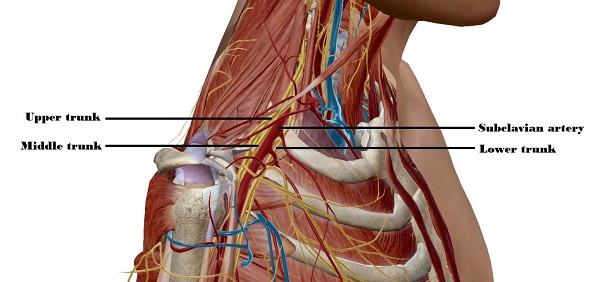It is a major peripheral nerve network formed by the anterior primary rami of fifth cervical to first thoracic spinal nerves. Brachial plexus innervates the muscles, joints, and skin of upper limb. There is a complex interchanging of branches before the formation of main nerves of upper limb. This network of nerves forming brachial plexus is divided anatomically from medial to lateral (or proximal to distal) into roots, trunks, divisions, cords, and terminal branches.
Quick Navigation

Roots
The root of the brachial plexus is formed by the ventral rami of C5, C6, C7, C8, and the T1 contributions of T1 spinal nerve. C5 spinal nerve also gives its dorsal ramus, dorsal scapular nerve, long thoracic nerve and contribution to phrenic nerve. C6 and C7 spinal nerves also give their dorsal ramus and contribution to long thoracic nerve. All spinal nerve give dorsal and ventral rami.
T1 thoracic nerve gives dorsal ramus that innervate the skin and muscles of upper back and the ventral ramus runs along inferior to the first rib. T1 contribution to the brachial plexus is from ventral rami that innervates upper limb. The rami enter to posterior triangle of neck between scalenus anterior and scalenus medius.
Trunks
There are three trunks which are upper, middle, and lower trunk. Upper trunk is formed by C5 and C6 root. C7 continues as middle trunk. The lower trunk if formed by C8 and T1. The C5, C6, and C7 nerve emerge deep to the scalenus anterior.

T1 contribution takes an upward course behind the pleura towards lower trunk. The lower trunk lies anterior to upper and middle trunk with subclavian artery passing anteromedially. This orientation helps in formation of anterior and posterior divisions of brachial plexus.

The upper trunk gives suprascapular nerve and nerve to subclavius. The suprascapular nerve innervates supraspinatus and infraspinatus muscle.
Divisions
All three divisions are divided into anterior and posterior divisions. These divisions pass through the cervico-axillary canal. The cervico-axillary canal is formed; posteriorly by scapula, medially by first rib and inferiorly by clavicle. The upper trunk divides into its anterior and posterior division slightly above level of scapula (2-3 cm). The middle and lower trunk divide deep to the scapula. Anterior division further supplies the flexor compartment of upper limb and posterior division supply extensor compartment of upper limb. Posterior divisions of upper and middle trunk are larger than their anterior divisions whereas the anterior compartment of the lower trunk is larger than its posterior trunk.

Cords
posterior cord. Anterior division of upper and middle trunk from lateral cord and; anterior division of lower trunk forms medial cord. Posterior cord innervates post-axial (extensor) musculature and; medial and lateral cord innervate pre-axial (flexor) musculature. Axillary artery lies anterior to all three cords, but there is variation in relation and formation of cords and axillary artery.
Lateral cord gives lateral pectoral nerve which innervates pectoralis major. The posterior cord gives superior subscapular nerve, middle subscapular nerve (thoracodorsal nerve) and inferior subscapular nerve. Superior subscapular nerve supplies subscapularis muscle. Thoracodorsal nerve supplies latissimus dorsi muscle. Inferior subscapular nerve gives two branches that supply subscapularis and teres major.
Medial cord gives medial pectoral nerve, medial cutaneous nerve (cutaneous nerve of arm) and medial antebrachial-cutaneous nerve (cutaneous nerve of forearm). Medial pectoral nerve supplies pectoralis major and pectoralis minor. Medial cutaneous nerve supplies posteromedial cutaneous region of arm; and medial antebrachial-cutaneous nerve supplies cutaneous region covering biceps brachii and posteromedial cutaneous region of forearm.
Terminal branches
Terminal branches of brachial musculocutaneous nerve axillary nerve median nerve radial nerve and ulnar nerve.
The musculocutaneous nerve arises from the lateral cord of brachial plexus and it gives cutaneous and motor branches. Cutaneous branches supply lateral forearm and motor branches are nerve to coracobrachialis, brachialis, and biceps brachii.
Axillary nerve arises from the posterior cord. Its cutaneous branch supplies the posterior and lateral surface of the deltoid. Motor branches supply deltoid and teres minor muscles.

